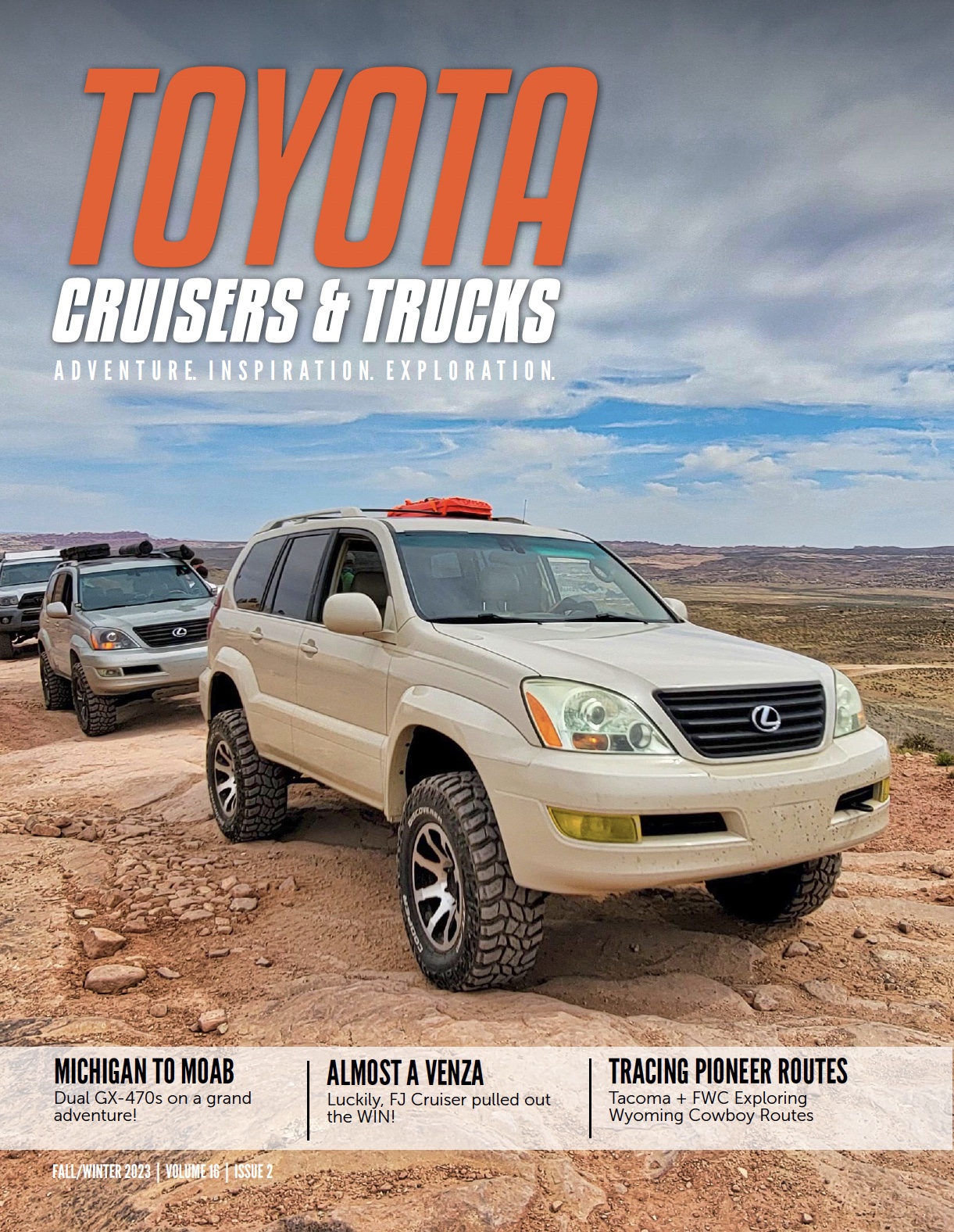We here at Tacoma Magazine have pulled together some useful tips that may help you make the most of those cold winter days that sideline most others and not become that truck who shuts down the road. Whether you are heading to the store for beer or heading into the forest for some exploration, know the weather and what to expect during your travels.
On-road:
• Drive for the conditions – slower speeds, slower acceleration and braking may be necessary.
• Do not use cruise control.
• Four-wheel drive does not make your truck invincible. You will have a hard time stopping and turning on slippery roads just as the rest of the drivers. It will help you get moving faster, but does not help you stop any faster.
• Leave more distance than normal between your vehicle and the vehicle in front of you.
• Anticipate slippery roads at intersections and turns. Slow down prior to approaching them.
• Remember that bridges will ice over sooner than the rest of the roads. Expect shady areas to have a higher chance of icy conditions.
• Be aware of your surroundings. If you notice an accident on the shoulder, there is a good chance there was an underlying condition that caused it. Do not overreact! Slow down and adjust your driving for the changing conditions.
• Do not slam on your brakes as this will only make things worse. Learn the point where your brakes will begin to lock up, and stay within the boundaries of non-lockup. If you have a manual transmission, learn to down shift (make sure to match rpm!) to help maintain a controlled deceleration.
• If you are a manual and are descending a hill while in 2wd, remember that if you down shift and are not matching rpms properly, your rear tires will have a tendency to begin sliding and fishtailing. Know your vehicle’s limitations!
• Watch out for slushy/adverse lane transitions when changing lanes/passing, as these are a common area for lost traction.
• Keep some warm clothes in the vehicle in case of emergencies.
Off-road:
• NEVER TRAVEL OFF-ROAD DURING THE WINTER ALONE!
• MAKE SURE OTHERS KNOW WHERE YOU ARE GOING!
• Determine the depth and consistency of the snow early on. Sometimes snow conditions will effect whether your group continues on or has to turn back. And keep in mind that snow conditions will change as the day progresses.
• Air down (10-20psi depending on tire and wheel. Some setups can allow you to go lower).
• Make sure you have all of the necessary recovery gear within your group.
• Bring extra clothes to change into (getting out of cold, wet clothes could save your life), extra food and water (more than if you were only traveling on-road).
• Keep camping supplies handy in case your day trip turns into an overnight recovery.
• Bring a water filter if you have one.
• Winch and winching supplies are essential if you are traveling off-road during the winter time. Even if it is only a hi-lift with chains and tow straps. Do not go out there without some sort of winching capabilities!
• Traction pads have become more popular in recent years and are a very handy tool to have in the snow. They can help in a quick recovery where winching would normally be required.
• CB and/or HAM radio. In many cases, cell phone service can be scarce where you may be off-roading.
• Spare parts and tools to aid in trail repairs.
• And do not forget your sunscreen!
Vehicle/Equipment tips:
• Go ahead and give your vehicle a fresh coat of wax prior to the winter season.
• Invest in a nice set of floor mats to help protect your vehicle’s interior from the mud, slush and snow that will be tracked into your vehicle.
• Make sure your tires are rated for the conditions you plan to drive in.
• Stop by your local tire shop and have your tires siped (the process of cutting tiny slits in the tread for increased traction in icy and hard packed conditions) if more traction is desired.
• Depending on the tires you have, you may be able to add studding to your tire for added traction in icy and snow pack conditions.
• Invest in a set of tire chains to aid in traction.
• Ensure you have proper fluids for the climate you are located in. Antifreeze, oil and windshield fluids are common areas of concern. Make sure to change out fluids before the cold weather hits.
• Top off your washer fluid periodically as you will use fluid much faster traveling on slushy streets. Keep extra fluid in your vehicle.
• Change out windshield wipers if necessary.
• If it recently snowed or saw freezing temperatures, make sure the wipers are free before turning them on. This will help prevent premature wear on your wiper blades.
• MAKE SURE AN ICE SCAPER IS IN YOUR VEHICLE IF YOU WILL BE IN WINTER CONDITIONS. That small hole you scratched open with your hand will not be sufficient, no matter how short of a distance you have to travel.
• Check your vehicle’s heating system PRIOR to cold weather.
• Check to make sure your headlights, turn signals and brake lights all work properly. It is important to make sure that you can see and be seen.
• If your battery is on its last legs, change it out before you are stranded in the freezing cold miles from home or a town.
Additional equipment/supplies to consider:
• First aid kit
• Blankets
• Flashlights
• Shovel
• Tow rope/strap
• Spare tire
• Tire chains
• Tire repair kit
• Air pump
• Vehicle jack
• Saw or axe
• Waterproof matches
• Duct tape and other sealants
Do not let winter keep you down. Be prepared, drive safe and get out there!
{fcomment}
Photos!
[flickr set=72157636584746604]
Related Articles
Remember, tell your friends! They can subscribe for FREE using this link!

 With Labor Day passing us by, the time has come to start ramping up for the winter season. Whether you will be fighting blizzards on your way to the mountain to catch first tracks or busting through snow on your local trails, having an ill-prepared truck and/or driver can quickly end to what could have been an amazing trip. Even if you are not a powder hound, there are many steps you can take to make sure that you and your truck are prepared for whatever old man winter may bring this year.
With Labor Day passing us by, the time has come to start ramping up for the winter season. Whether you will be fighting blizzards on your way to the mountain to catch first tracks or busting through snow on your local trails, having an ill-prepared truck and/or driver can quickly end to what could have been an amazing trip. Even if you are not a powder hound, there are many steps you can take to make sure that you and your truck are prepared for whatever old man winter may bring this year.









